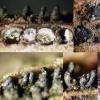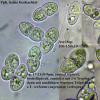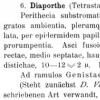
08-02-2011 10:47
Quijada LuisDear Colleagues,I have long tried to get these two

08-02-2011 01:09
Erwin GruberHave another try - i am a little disappointed beca

08-02-2011 00:42
Erwin GruberFungi exsiccati praecipuae Gallici 6893 was the fi

06-02-2011 11:07
Bonjour à tous, Quelqu'un aurait-il parmi vous c

05-02-2011 01:33
 Yannick Mourgues
Yannick Mourgues
Bonsoir à tous. Afin de compléter un article, j

04-02-2011 12:58
Marja PennanenHello folks, as I mentioned in the ealier O. vi

03-02-2011 11:47
Marja PennanenHello, it's still winter here and will be for 2

01-02-2011 07:42
Gernot FriebesHi, a friend of mine found this pyrenomycete on
Diaporthe genistae?
Björn Wergen,
09-02-2011 17:00
 Hello again,
Hello again,I have found a Diaporthaceae on Genista with the following features:
Perithecia clustered, sphaerical with a beaked ostiolus, black, reminds on D. strumella.
Spores broadly ellipsoid, hyalin, first with a few bigger guttules, then filled with many small ones, with a central septe and a constriction there, smooth.
Asci with 8 spores (uniseriate), ca. 100-150x10-12 µm.
Found on dead stems of Genista. I didn't find any literature about this species, unfortunately Ellis&Ellis didn't mention it under Genista...
Is it D. genistae? I know about Diaporthe-species with their relation to specific substrates but its just a guess, perhaps somebody can give a hint for literature ;)
regards,
Kazuya
Gernot Friebes,
09-02-2011 18:29
Björn Wergen,
09-02-2011 18:56

Re:Diaporthe genistae?
hmm thanks Gernot for help, D. inaequalis has spores around 12-18x7-9µm (see Ellis&Ellis 1997). The spores of my finding has 17-21x8-9. If the different size isn't a problem, it could be D. inaequalis ;)
regards,
Kazuya
regards,
Kazuya
Gernot Friebes,
09-02-2011 19:04
Re:Diaporthe genistae?
Munk (Danish Pyrenomycetes) gives 16-24 x 8-12 µm for D. inaequalis, so quite a huge range.
Best wishes,
Gernot
Best wishes,
Gernot
Björn Wergen,
09-02-2011 19:06

Re:Diaporthe genistae?
It seems as if my literature is not good enough for me to make larger studies about pyrenomycetes :D
thanks again Gernot, if you have some material about Diaporthe, I am always interested ;)
regards,
kazuya
thanks again Gernot, if you have some material about Diaporthe, I am always interested ;)
regards,
kazuya



